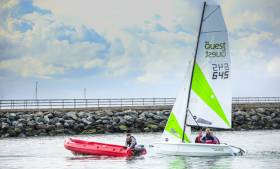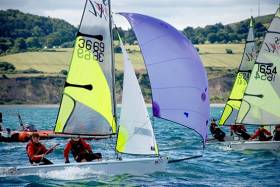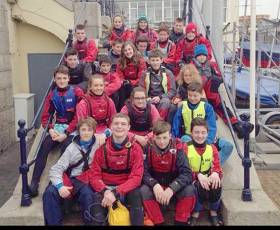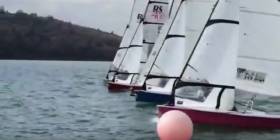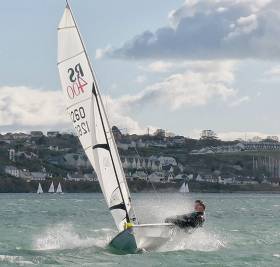Displaying items by tag: RS Sailing
RS Sailing Releases Statement On Death Of Yachtsman At Cowes Week
#CowesWeek - RS Sailing released a statement expressing its members “deepest sadness” following the death of a sailor during Cowes Week on Friday (10 August).
The man in his 60s was thrown overboard from an RS Elite class yacht in Osborne Bay on Friday afternoon. He was picked up by a RIB and brought ashore but later pronounced dead at St Mary’s Hospital on the Isle of Wight.
“Our thoughts and prayers are with the family and friends, many of whom were racing that day,” the statement from RS Sailing reads. “Those most closely involved could hardly have been more experienced or acted more proficiently. We salute them and their efforts.
“But accidents can happen in almost anything worthwhile that we do, and our lost friend would want us to sail on with a smile and keep on loving it as he was doing right up until tragedy struck.”
RS Quest Training Dinghy Makes Dun Laoghaire Debut at INSS
The new RS Quest family and training dinghy has made its Dun Laoghaire debut, thanks to its new RS Irish agents based at the east coast port.
RS agent Kenneth Rumball of the Irish National Sailing and Powerboat School was appointed last month to the new sales role.
The INSS used the boat recently for RYA and ISA instructor training courses, leading school founder Alistair Rumball to declare the new marque 'very versatile'. Top marks indeed!
The RS Quest is a modern family or training dinghy with features that move the game forward. Big enough for an instructor and 2 or 3 pupils – perfect for Mum or Dad and youngsters – small enough to handle easily ashore and afloat. Inspired by the UK Sea Cadets to replace their aging fleet, the RS Quest has rapidly become the best-selling dinghy of its type worldwide.
Durable rotomoulded polyethylene construction – space and stability – reefing, spinnaker, stowage and a host of other options. It’s not easy to make it all work but our development team have nailed it on this boat. With options of Symmetrical or Asymmetrical Spinnaker use there really are all the options available.
"We have chosen the Quest due to its huge versatility. From getting children afloat for the first time to advanced adult teaching, there now is one boat that can do it all", according to Kenny Rumball.
More on the RS Quest here
RS Sailing has appointed two new dealers in Ireland following the retirement of Belfast–based McCready Sailboats. The Irish National Sailing and Powerboat School has been appointed in Dublin with a new chandlery appointment in Northern Ireland too.
New RS agent Kenneth Rumball of the Irish National Sailing and Powerboat School is one of Ireland's top sailors with success in the Optimist, 420, Fireball and offshore. Rumball brings a wealth of racing and sailing knowledge to the team. Together with Brian Spence (formerly of McCready) Bosun Bobs Chandlery will represent the brand in NI.
The RS400, 200 and Feva classes are widely sailed across Ireland.
This is an exciting year for RS Sailing who celebrate 25 years racing with one of the world’s biggest ever dinghy events when the RS Games kicks off at Weymouth in August. The anniversary year will also see the launch of three new boats.
New for 2018
RS Zest - Brand new compact boat that replaces the RS Quba and delivers more crew space and practical, enjoyable features than older generation rivals.
RS CAT14 - This boat takes the enjoyment and handling associated with beach cats to a new level.
RS21 - Progressive keelboat solution for club programs and sailor teams. The RS21 is specially designed for fleet purchase, with attributes that will appeal to individual buyers as well.
The RS Feva class is seeking to repeat its great turnout of 38 boats at the 2016 Greystones Sailing Club hosted National Championships. 'There is no reason why we can’t achieve similar numbers at our events this year', according to upbeat class officers.
The opening Feva event at Howth Yacht Club in April will also have the RS200, RS400, SB20 and National 18 fleets taking part.
2017 Irish RS Feva Events Calendar
April 22,23 Easterns Howth YC
May 13,14 Northerns RNIYC
July 1,2 Southerns RCYC (as part of Dinghyfest)
July 14,15,16 Nationals RStGYC
July 21-27 Worlds Holland
Aug 12,13 Inlands Blessington SC
RS200s Put Through Their Paces at Royal St George YC Training Weekend
The RS 200 fleet enjoyed great conditions at the Royal St George YC at the weekend.
Olympian Saskia Tidey – just back from racing at Miami Olympic Classes Regatta – gave an intensive weekend's coaching. Tidey, now the team GBR 49erFX crewmate of Charlotte Dobson, kept the pace up relentlessly over the the two days and crews made noticeable improvements.
The fleet spent almost five hours on the water on the second day in an amazing, sunny force 3-5.
The training weekend is part of an Irish RS class initiative to breathe new life into dinghy sailing. All Ireland champion Alex Barry of Cork, an RS champion, told Afloat.ie that 'friendships through sailing is key to the future of dinghy classes'. Read more here.
RS 200 Training Weekend Photos
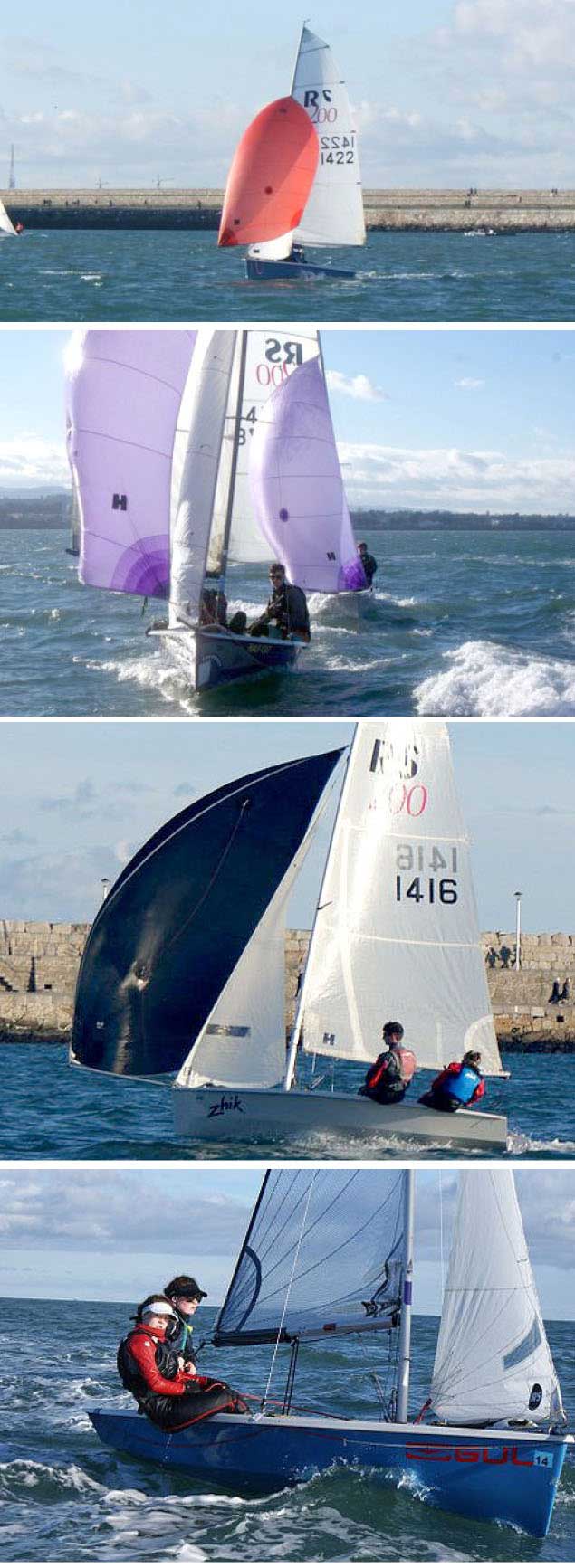
Friendships Through RS Sailing Key To Future Of Dinghy Classes Says All Ireland Champ
#RS200 - Friendship is key to keeping Ireland’s youth dinghy sailing classes alive, according to this year’s All Ireland Champion sailor Alex Barry.
Speaking to Afloat.ie ahead of January’s RS200 open days at the Royal Cork Yacht Club, Barry laments that the numbers participating are “certainly not enough”.
While clubs and associations around Ireland are doing “a really good job” with junior classes since the ISA’s shake-up, and the high performance team has celebrated Olympic success, there remains “a void” for over-16s “who just want to have a bit of fun, go to a few events camping, and be with their friends.”
Barry points to the traditional route into sailing — and in particular the transition to bigger boats and team racing at university age, after starting in Optimists and skilling up in Lasers or Toppers — as the point where many young sailors drop out, prohibited by the significant investment, among other factors.
“My goal is to get the parents to reinvest that €4,000-€5,000 from [the sale of a Laser or Topper] into a 200, which can keep people sailing through that financially tough period,” says the Royal Cork member and RS400 champion.
“If they make it through that with a boat and maintaining the friendships, I believe the chances of them staying sailing are much greater, thus driving dinghy sailing forward.”
The first RS200 open days of the new year take place next weekend Saturday 7 and Sunday 8 January, with another weekend of open days to follow on 21-22 January. More details are available to download below.
Royal St. George Yacht Club under–19 pairing Henry Start and Morgan Devine were the winners of the RS Feva Nationals at Greystones Sailing Club yesterday. The Dubliners finished on the same points as under–14 Welsh visitors Eddie and Kevin Farrell from Llandudno Sailing Club in second overall. Third was another Royal St. George YC pair, Jamie Matthews and Adam Rochford. Download overall results below.
Eight races from a scheduled nine were sailed over three days with Tuesday's racing lost due to lack of wind. Yesterday's intense final day featured five races in moderate conditions.
In a massive improvement of fleet numbers from 12 in 2015 to 38 in County Wicklow this week, Class Chairwoman Elaine Malcolm thanked the sailors for the upsurge in numbers and fleet sponsor McCready Sailboats Ltd. The next event on the RS Feva Irish programme is this weekend for the Waterways Ireland sponsored Inland championships 2106 at Lough Ree Yacht Club.
Royal St. George YC Hosts RS Feva Easter Clinic 2016
The RS Feva class had a really successful training clinic over the Easter holidays, with 26 sailors taking part over the 3 days. Led by our National coach, Stephen Craig, assisted by Meg Tyrrell, we had great pleasure in welcoming sailors from Galway, Malahide and Greystones as well as those from the RSGYC and NYC. It was great to see so many new faces coming in to the class this year writes Elaine Malcolm
On the Sunday we started the day with some ice breakers and a rigging session, where everyone participated in rigging a Feva from scratch. We launched soon after and began with a warmup inside the harbour, before heading outside the harbour where we did upwind exercises with focus on pointing and lane holding. Tacking on the whistle allowed us to coach each sailor individually from our RIBs as they sailed upwind. We followed by doing long downwind grinds with focus on efficient hoists and drops. Conditions were light to moderate.
On Monday conditions were lighter still, although in the morning we managed to get in some upwind training with a focus on roll tacking and boat balance, with an improvement in both of these aspects. When the wind did drop to virtually 0 knots halfway through our session, we carried out games to keep the sailors entertained for the remainder of the water session.
On Tuesday we started off with about 0-2 knots, and so we planned for a day with very little breeze. We launched and did some fun races and games, however halfway through our session the wind filled in to about 7 knots and we managed to cover some upwind practice followed by downwind training. We put a focus on angles when sailing downwind and how to sail the best possible course. We then ended the day with a session on starts and how to find the bias, followed by races. When we returned ashore there was pizza waiting for the sailors as a very welcome way to end the clinic.
Seven RS400s for Royal Cork Sprint Series (Video)
There were seven RS 400's on the water in Crosshaven this weekend. Sailing out of the Royal Cork Yacht Club the young fleet had a training session on Saturday and a six race Sprint series on Sunday. The video below is race two yesterday which shows just how tight the racing is. Alex Barry and Robbie English were 1st, Andrew Woodward and Richie Harrington 2nd and John Downey & Sandy Rimmington 3rd.
The class continues to grow with 10 boats now regularly on the water as they prepare for a busy year ahead, the first event will be the Easterns in the Royal St George YC in Dun Laoghaire on 23/24th April and the pinnacle will be the nationals in Schull on 26-28th August.
RS400s Hit The Water At Royal Cork Yacht Club
Five RS400s hit the water in Cork on Saturday, the first day back for a fleet that has now grown to 11 boats in Cork Harbour.
Hosted by the Royal Cork Yacht Club, racing took place on the Curlane Bank and the 10 hardy souls completed 5 races in glorious sunshine and winds gusting to 25 knots.
John Downey and Sandy Rimmington of Monkstown Bay were clear winners on the day with a score line of three 1sts and two 2nds.
Dublin based dinghy supremos Barry MacCartin and Ronan Wallace were a convincing second and are proving to be the ones to watch for the regional circuit.
Twice national champs Alex Barry and Richie Leonard could only manage third however were delighted with their swimming practice.
George Kenefick paired up with Royal Cork junior Harry Durcan and they finished fourth, also getting in plenty of swim time as they blew off the cobwebs.
New to the class Tom McGrath rounded it out in 5th. It was great to see the young blood getting involved and Junior ace Harry Durcan joined Tom, moving to the front of the boat for the first time.
Thanks to OOD Ciaran McSweeney and all of his helpers on the day.
The class have a packed local and national schedule this year as they build towards the nationals in Schull in August.



























